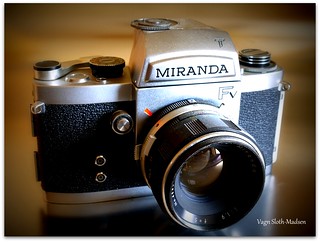Miranda Fv

|
| Fv with VF3 finder image by Matt Phillips (Image rights) |

|
| 1966 Miranda FvT image by Vagn Sloth-Madsen (Image rights) |
The Miranda Fv belonged to group of Miranda cameras made between 1963 and 1969 - starting with the F - which was modified to become the Fv (via the FM). As with most Miranda SLR cameras before and after the Fv, the finders are interchangeable, so can be prism, waist-level, magnifying or ... something more.
The T finder was introduced in 1967 as an accessory for the Miranda G, and incorporates an uncoupled TTL CdS meter built into a prism housing. So, the 1967 Miranda GT is the same camera body as the 1965 G, but for the addition of the T finder, and the 1968 Miranda FvT is the same camera body as the 1967 Fv, but for the addition of the T finder.
The Fv/FvT was a slightly lower specification model than the G/GT, which had an oversized mirror with a lock-up for wide-angle lenses, plus interchangeable viewfinder screens, and was known as the poor man's Nikon F. That's quite an accolade.
The Miranda Fv boasts a fairly standard layout and specification for the time, but also offered some neat additional features and quirks.
- The Fv (and other models) have two separate shutter release buttons; one in the usual location on the user's right of the top plate (although this was a screw-in post, and is frequently missing), and the other on the front of the camera body. Older Miranda camera models were pioneers of systems to automate closure of the lens diaphragm immediately prior to exposure, and used an external mechanism known as a Pressure Automatic Diaphragm. PAD lenses had an arm with a button on the end that reached to and aligned with a body shutter release. Pressing the release button on a lens arm closed down the diaphragm, and then further pressure pushed the camera shutter release. Miranda where very mindful of providing backwards compatibility, so that's why the Fv has two shutter release buttons, and one of them is on the front of the camera: it's a legacy feature to accommodate the use of older Miranda PAD lenses with external diaphragm couplings. The Fv/FvT is otherwise designed to be used with newer Miranda lenses with internal automatic diaphragm couplings.
- Further backwards compatibility is seen in the lens mount, which is both a 4-claw bayonet for auto-diaphragm lenses, and a 44 mm screw mount for older lenses.
- The T metering prism is used in much the same way as a hand-held meter. It offers the advantage of measuring light levels through the camera lens, but requires the user to look away in order to establish what level of illumination the meter has registered. The scene has to be framed and a small button on the side of the prism pressed, which invokes a light measurement that is locked when the button is released. Turning a dial to match the meter needle position allows shutter speed and aperture combinations to be read, and manually transferred to the camera/lens. The T meter works like any other hand-held device, except for the need to observe the maximum aperture of the lens mounted to the camera. This step is the equivalent of setting the maximum aperture on a Topcon, or indexing a pre-AI Nikon lens. Essentially, the level of illumination observed though - say an f/4 aperture - is going to be half that of an f/2.8 aperture, so the meter needs to be informed what it's looking through in order to evaluate what it's looking at.
- A delightful design quirk can be found in the frame counter, where the marker that points to a digit on an arc of numbers changes colour from white to red when the film is wound.
- The shutter speed dial has central post with a coin sized slot ... to enable its easy removal. This is to allow the fitting of a snap on exposure meter, which couples to the shutter speed dial. The snap on was made for the Fv (and G), as an alternative to the T prism meter. The snap on is a direct measurement device (i.e. not TTL). There was also an alternative plug-in direct measurement meter within a prism, which was initially produced for the Miranda FM.
Specifications
Lens mount: Miranda mount - duel 4-claw bayonet and 44mm screw thread.
Focus: Viewfinder magnification 0.92x with 50mm lens at infinity. Condenser and Fresnel lens combined focusing screen with micro-prism centre spot. Interchangeable viewfinders.
Shutter: Horizontal travel cloth focal plane with speeds of 1 sec., to 1/1000th sec., +B. No self-timer.
Meter: Various removable accessories.
Exposure: Manual.
Flash: FP and X terminals. X synch at 1/45th sec. No accessory shoe - this was an extra that clipped over the rewind knob.
Film Advance: Winding angle 180°. The film winds on to the spool emulsion side out.
Size: 146 x 95 x 45mm.
Weight: 640g (body only).